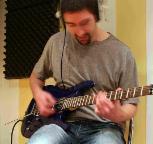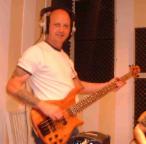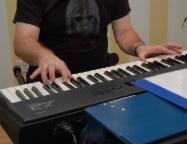


Rock and Pop Group Recording
We can record your band in two ways. The first method involves you all playing together, at the same time, as you would at a gig. This has the advantage of giving a live feel, though it does limit the options when it comes to editing. It also means that you've all get to get a perfect performance every time! The alternative, which is much more common these days, is to record the instruments separately, starting with drums, with performers listening to previously-recorded tracks on headphones. At this stage, I'll assume we're going to adopt this approach. There's some more info on the 'Recording Concepts' tab below.
Drums Microphone selection is one of the keys to getting the drum sound that you want. Try the AKG D112 or the Audio Technica Pro-25 on kick drum. Both sound fabulous, but completely different. Kick is so important, so try to make time to try both, if you can. On snare, Shure SM57, top and/or bottom - enough said. Depending on the sound you're looking for, AKG C1000's or Shure SM57's or Shure PG56's are available for toms. For overheads, either a pair of Rode NT5's will add real sparkle to your cymbals or for a warm sound then AKG C3000's. Oh yes, and the incredible Beyer M201 on hi-hat gives sizzle and unbelievable separation. The drummer can have a click-track in headphones (reccommended), or alternatively a temporary guide vocal.
Many Bassists like the sound of their instruments through a DI box. This adds real presence to the sound. Alternatively, I can mic up your amp with one (or more) dedicated bass microphones.
For Electric Guitar, I can mic up you amp with either the Sennheiser E606 or another SM57, which gives real bite to the sound, or a condenser mic for a warmer sound. Try both, individually or together. A modern alternaltive is to use my Line-6 'POD' physical modelling pre-amp. This wonderful piece of kit creates the sound of every amp you ever dreamed of. It can be a Marshall stack, a Vox AC30, a Mesa-Boogie or indeed any one of 40 classic amps for you to try. You can even change the amp at mixdown! Definitely worth a try. For a clean guitar sound, I have a small Fender valve amp, which you're welcome to use.
Acoustic guitar is very popular at the moment. Consider adding some to your demo, even if you wouldn’t on stage. I know how to accommodate it in the mix.
Keyboards are usually recorded as MIDI tracks and I can easily sync up to 32 stereo keyboard tracks to the rest of the band. Use your own MIDI gear, or help yourself to some of mine. Don’t forget that I can hire in, or sample, anything exotic which you need for the record.
Every vocalist is different, so you really must take time to try each of the selection of condenser mics, including the Rode NT2 and the strange-looking Russian Oktavia mic. Or, if you must, there's always the trusty Shure SM58. Bono still uses one on all U2's records.
One thing which can really add class to any demo is quality backing vocals. I know all the tricks to get your BV’s to stand out, including multi-tracking, harmony and even pitch correction, if necessary. Allow time for BV’s – they really do make a difference.
I've probably had experience of recording any other instrumentalists which you have, whether it be a brass section, percussionist or just a tambourine.